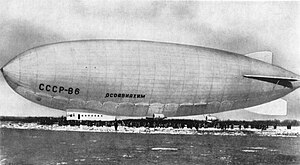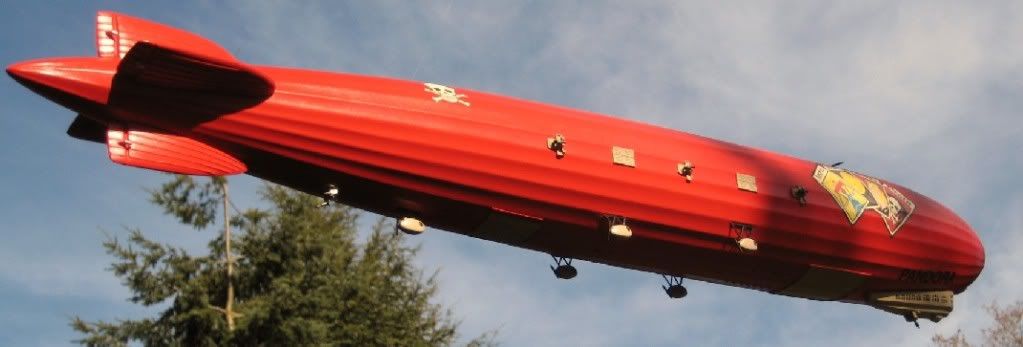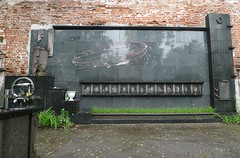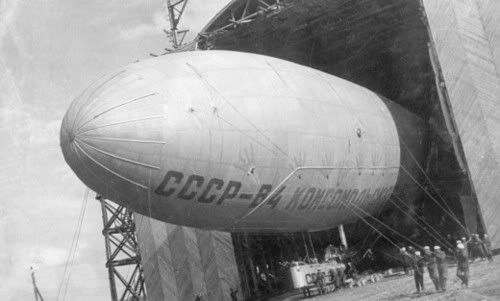SSSR-V6 OSOAVIAKhIM
The airship USSR -W6 " Ossoawiachim " (Russian СССР - В6 Осоавиахим ) was the greatest success of the Soviet lighter- than-air fleet and also the largest in the USSR (Soviet Union) ever built airship. In October 1937, broke with a traveling time of 130 hours and 27 minutes continuous driving record for airships of all classes. Ossoawiachim was the name of the " Society for the Advancement of defense, aviation and chemistry ."
About the Soviet airships are few, sometimes contradictory and hardly verifiable information available. This is the one on the run by the Soviet Union secrecy which practically did not reveal any information, and secondly to the propaganda which, although often applied for large projects which have, however, in the dark, let due. Therefore, the information in this article should be considered critical.
Formation
Not least by the visits of large airships like the Norge and the LZ 127 "Graf Zeppelin" grew up in the Soviet Union, the desire to build large airships. It therefore invited the Italian Umberto Nobile airship designer, advance the airship in the Soviet Union. This decision was approved by Stalin himself, while Mussolini, is good propaganda for Italy hoping for, agreed.
Nobile moved to Moscow in May 1932. He stood there, however, at the very beginning. The Boatyard initially possessed neither an airship hangar, nor about workshops or material. Nobile was entrusted with the education of future Soviet aeronaut and technicians. The design and construction of the airship began after many hurdles in the summer of 1933.
As usual for Stalin and the Soviet Union, such projects were not alone in the responsibility of a foreigner. Regardless of Nobile built Soviet technicians in August 1934, a semi-rigid airship with a volume of 9150 m³. It was designated W7. However, it was destroyed just days after the completion of the airship hangar by fire.
However Nobile's work continued. W6 conducted its maiden voyage on November 5, 1934 by Umberto Nobile below. Two days later, the ship sailed triumphantly to Moscow and was part of the celebrations of the October Revolution. The W6 was " Ossoawiachim " (short for Obschtschestwo sodejstwija oborone, aviazionnomu i chimitscheskomu stroitjelstwu - Society for the Advancement of defense, aviation and chemistry (Russian Общество содействия обороне, авиационному и химическому строительству ) ), named after an organization that aviation, the should make it popular among the general public.
Technology
W6 was an evolution of Nobile's Italia with a length of about 105 m, a diameter of about 18-20 m, a volume of 19 400 m³ and 8500-9640 kg payload. The lifting body was divided into six gas cells. The net mass was about 12 tons, the starting weight 21.3 t. The cable length was 15.12 m. Three piston engines with a total of 590 kW ( another source: 3x191 kW) allowed a speed of 93 km / h Other sources speak of 115 km / h The ship was powered by a 15-member crew.
Operation
All during the stay Nobile 1931 to 1936 in the Soviet Union built airships were intended for passenger transport. USSR -W6 should ride the line between Moscow and Sverdlovsk, but could not be used because there were no hangars, masts and anchor options to refuel. In 1936, finally, a mooring mast was erected in Sverdlovsk.
1937 led airship captain Pankow W6 a 79 -hour successful test run on the route Moscow - Sverdlovsk - Moscow and constantly running motors, permanent record run of 130 hours and 27 minutes through. The record attempt began in Dolgoprudnyj (Russian Долгопрудный ) on September 29 and ended on October 4. The distance traveled was supposedly around 5000 km. These trips were held to prepare a regular airship transport.
The source location to other rides is very thin.
The end
On February 5, 1938 at 16:45 clock, the ship sailed to his doom. A group of Soviet Arctic researchers Ivan Papanin had the drift station North Pole-1 obtained in the vicinity of the North Pole, which eventually drove the east coast of Greenland. There, the ice began to break up, after which the crew on February 1, 1938 set down a cry for help. Then USSR -W6 was sent out to host researchers. The accident happened during the transfer from Moscow to Murmansk. This trip was supposed to serve as a probation test for arctic conditions. From Murmansk from the aeronaut then wanted to accommodate the researchers set off towards Greenland.
The ship collided near Kandalakscha with the 324 m high mountain Neblo (Russian Небло ). According to the official version of a sink to 30 m was located below sea level on the " pre-revolutionary " cards at the crash site. Unofficially, it is reported that the command from the first commander Nikolai Gudowanzew was due to the mistrust of the old maps and the poor visibility, rising to 800 m. Ivan Pankow, second in command, however, was when running a lot of time, because he feared losing orientation in poor visibility. He stayed instead at an altitude of 300 m. Of the 19 people on board, 13 people died in the cabin, three others were injured.
The grave of the aeronaut is located in the Novodevichy Cemetery in Moscow. The researchers on the ice were rescued by icebreakers. It is believed that this accident was also the reason for the end of the then Soviet airship program.
In 1968, on the mountain Neblo where the airship crashed, built by students and the local administration a monument beside the still existing ruins.










